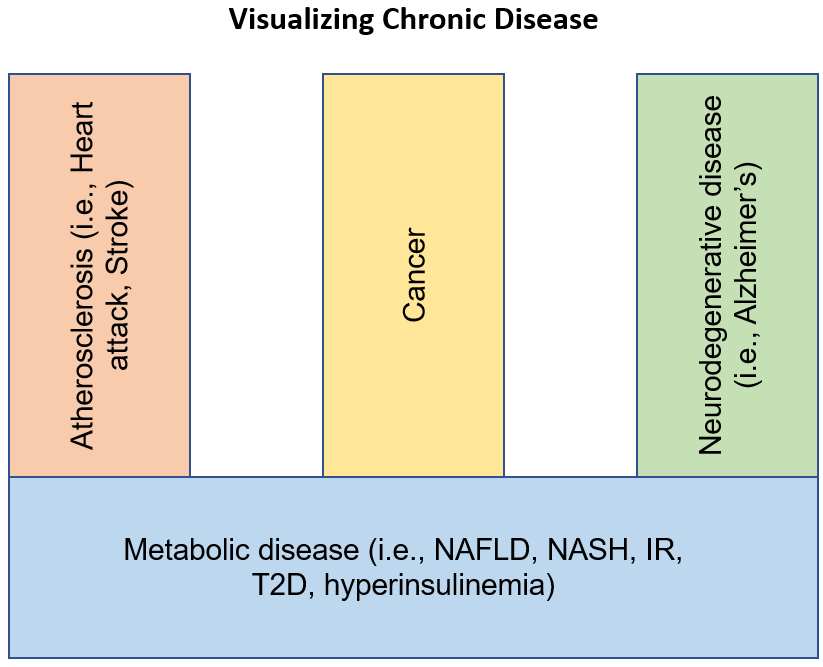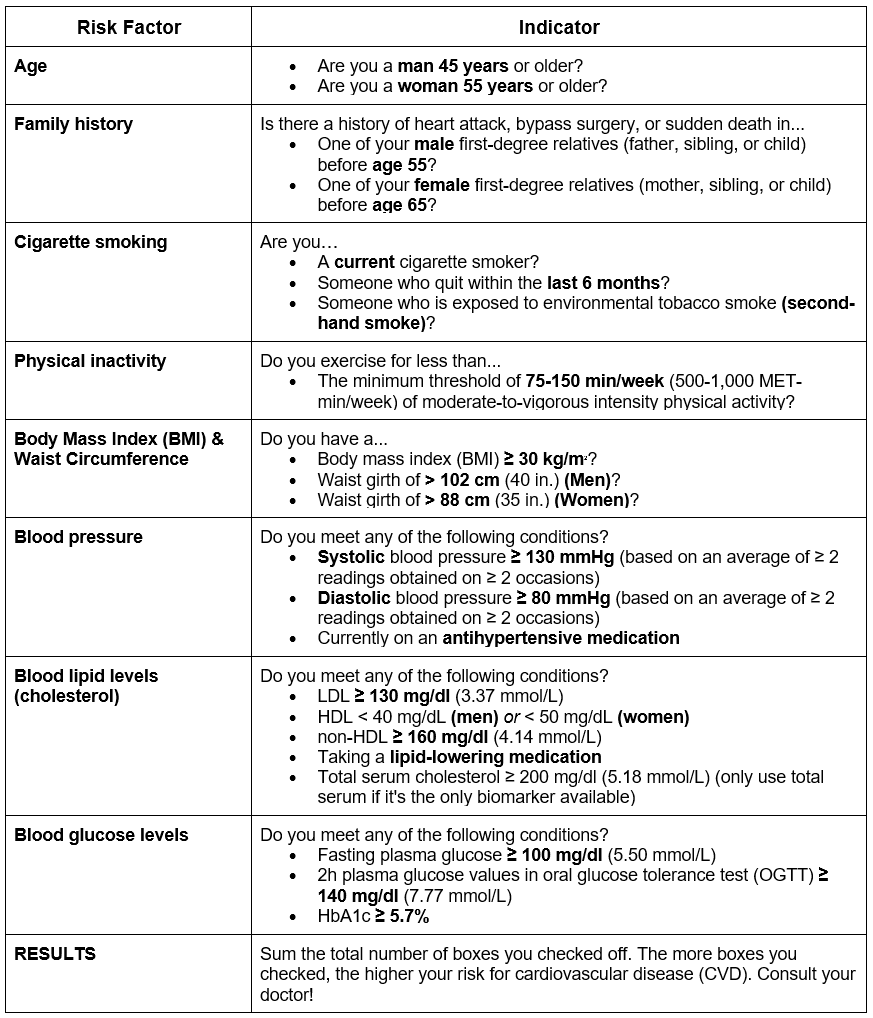Longevity Minded - Battling Cardiovascular Disease
Battling Cardiovascular DiseaseDismantling the biggest killer in Western nations and formulating a plan of attack.
Cardiovascular DiseaseAs I wrote in The Four Horsemen, a large piece in the puzzle of extending lifespan is figuring out how to delay the onset, or reduce the likelihood, of developing four chronic diseases. Combined, these four diseases are responsible for killing roughly 80% of people within Western nations. If The Four Horsemen had a team captain, it would be cardiovascular disease (CVD). CVD is the main culprit in a group of diseases that are caused by atherosclerosis (orange pillar above). Atherosclerosis is simply the thickening or hardening of arteries caused by a buildup of plaque in the walls of the arteries. Considering that CVD is responsible for the lion’s share of this 80% (although cancer has narrowed the gap in recent years), I propose two reasons why we should familiarize ourselves with its risk factors:
Positive Risk FactorsThere are eight positive risk factors for CVD. These are the boxes we don’t want to check as the more that are applicable to us, the higher our risk. Each risk factor is explained below and a summary chart is provided at the end so you can perform a self-analysis. This analysis should aid in promoting certain lifestyle changes and improving discussion with your physician. But first, a few important caveats. Changing tides. As you’ll see, most of the eight indicators below are scored against some form of measurement or marker. This is a useful way to analyze individuals for risk but as new science emerges, thresholds are updated. For example, an individual with a blood pressure (BP) of 140/90 (systolic/diastolic) and above was considered an at-risk individual for CVD. If you were below those numbers, BP was not considered a risk factor for you. Recently, this threshold was lowered to 130/80. If you were someone with a blood pressure of 135/83 you weren’t considered at-risk one day but were the next simply due to a change in how we evaluate risk. Bottom line: standards change. Not at Risk vs. Optimal. Although the thresholds for each marker below serve as useful tools to differentiate an at-risk from a healthy person, they should not be confused with optimal levels. If you want to live to 100, you have to have the body and internal functioning of a 40-year-old when you’re 60 (not scientifically, but you get the idea). Sticking with our BP example, if you have a reading of 128/78 you aren’t considered “at-risk” but you’ll probably want to drive those numbers down further away from the upper limits if you plan to live longer than average. Optimal ranges for these indicators won’t be addressed in this article, but it’s an important distinction to keep in mind. We aren’t aiming for “not at risk”, we’re gunning for “you have the body of someone 20 years your lesser.” Let’s dig in. AgeCVD, and atherosclerotic diseases in general, is a time exposure disease meaning that the older we are, the greater our risk. Men aged 45+ and women aged 55+ are at greater risk of developing CVD. We can’t control this one so I won’t spend any time belabouring the point. Family HistoryThose with a history of heart attack, bypass surgery, or sudden death in a male first-degree relative (father, sibling, or child) before age 55 or a female first-degree relative (mother, sibling, or child) before age 65 are at greater risk of CVD themselves. Again, this is beyond our circle of control, so there’s little use in worrying about it. Thankfully, our risk for the remaining six factors is largely in our hands. Cigarette SmokingIf you’re a current cigarette smoker, someone who quit within the last 6 months, or someone who’s exposed to second-hand smoke, you’re at higher risk for CVD. If you smoke, quit. How? Tell everyone you know that you quit smoking, whether you have or not (yet). Post it on social media and shout it from the rooftops that you no longer smoke. Social stakes work wonders. This technique applies to any habit formation or cessation you’re working on. Physical InactivityThe minimum threshold of physical activity is 75–150 minutes per week of moderate-to-vigorous intensity physical activity. If you fall below this range then you’re at higher risk for CVD. If you don't yet exercise, make it as easy as possible. I recommend downloading the Nike Training Club and the Nike Run Club apps. Perform three to four of those guided workouts and runs per week and you’re well on the way to driving down your risk for CVD. If you already exercise and are looking to expand the breadth and depth of your practices, check out these articles on aerobic and anaerobic training, strength training, and stability, flexibility, and mobility. Bottom line: get moving in a way that is enjoyable and sustainable for your lifestyle. Exercise is one of the most potent tactics we have to drive down our risk of all-cause mortality, including that from CVD. Body Mass Index (BMI) and Waist CircumferenceIf you have a body mass index (BMI) of ≥30 kg/m2, are a man with a waist girth >102 cm (40 in.), or a woman with a waist girth of >88 cm (35 in.), then you’re at higher risk for CVD. Although BMI is widely used and has some practical application when assessing large datasets such as a population, it offers very little insight at the individual level. Take me for example. I weigh approximately 90.7 kg (200 lbs) and stand 1.85 m (6-foot 1 inch) tall. This indicates a BMI of 26.5. If a physician saw this number on a piece of paper, they’d think a severely overweight patient was about to walk through the door. Yet, I have a visible six-pack. For me, and others with similar body compositions, this calculation fails to incorporate a higher-than-average muscle mass and lower-than-average body fat. The essence of what is being determined with these indicators is the proportion of your total mass that is made up of body fat. In other words, body fat percentage. Lower body fat, up to a point, equates to a longer and healthier life. Thankfully, we have much better tools to assess our body fat such as DEXA Scans (deep dive here) and BodPods. Both tools are affordable and provide useful insights other than body composition (lean mass and fat) such as bone mineral density. Work to maintain a healthy weight year-round and you’re making strides in lowering your risk of developing CVD. Blood PressureIf you’re someone with a systolic blood pressure (SBP) ≥130 mmHg, a diastolic blood pressure (DBP) ≥80 mmHg, or on antihypertensive medication, you’re considered at higher risk for CVD. The blood pressure readings should be based on an average of ≥2 readings obtained on ≥2 occasions. SBP is the top number on your blood pressure reading and indicates the force of blood against your artery walls (blood vessels) while your ventricles (the lower two chambers of the heart) contract, pushing out blood to the rest of the body. Conversely, DBP sits on the bottom of your reading and measures the same force during the relaxation of the heart, or in between beats, which is when the ventricles refill with blood. High blood pressure can lead to a number of health ailments such as damage to the arteries of the heart and brain and kidney damage. In effect, high blood pressure is the main cause of both stroke and heart failure and one of the two major causes of kidney disease. For these three diseases, the higher the pressure equates to a higher risk of developing them. Although our focus here is CVD, it’s important to understand that blood pressure plays an important role in every major chronic disease except for cancer. Needless to say, controlling and maintaining healthy blood pressure levels is critical in our quest for a longer, happier, and healthier life. Blood Lipid LevelsBlood lipid levels when determining CVD risk are measured through cholesterol. We have two types of cholesterol. High-density lipoprotein (HDL) is known as “good cholesterol” whereas low-density lipoprotein (LDL) is the “bad cholesterol.” The more of the following conditions you meet, the greater your risk for CVD:
Cholesterol is a fat-like substance that comes from the foods we eat and our liver. It helps our body produce cell membranes, various hormones, and Vitamin D. Cholesterol is carried through our bloodstream in molecular proteins called lipoproteins, of which the two most commonly known are HDL (good) and LDL (bad). LDL molecules have been shown to release the cholesterol they carry into the bloodstream which contributes to the accumulation of atherosclerotic plaque. This buildup can eventually lead to heart attack, stroke, and peripheral artery disease. On the other hand, HDL safely transports cholesterol through the blood to the liver where it’s metabolized. In reference to the bulleted indicators above, studies show that LDL may be a more predictive indicator of CVD risk than total cholesterol levels. Blood Glucose LevelsBlood glucose is the amount of sugar in a person’s blood. Aside from being a risk factor for CVD, one’s levels may also indicate a plethora of metabolic diseases from insulin resistance to Type 2 Diabetes. If you meet one or more of the below criteria, you’re at a higher risk for CVD:
Plasma glucose is simply the amount of glucose in the bloodstream. These three measures act as markers to assess the body’s metabolic function. Elevated levels of glucose circulating in the bloodstream, as indicated by the three measures above, results in a chemical imbalance that impedes the use of lipids. This metabolic imbalance causes individuals to be more susceptible to atherosclerosis and as a result CVD. Hemoglobin A1C (HbA1c) is a blood test that tells us how much of our hemoglobin is bound, or joined, to glucose – the hemoglobin is ‘glycated’. Hemoglobin is the protein in red blood cells that carries oxygen throughout the body and the amount of HbA1c formed is in direct relation to the amount of glucose in the blood. In essence, consistently elevated blood glucose levels will result in a host of metabolic issues over time ranging from insulin resistance to the potential development of Type 2 Diabetes. Metabolic diseases have significant causal ties to the three diseases, cancer, atherosclerosis, and neurodegenerative disease, that are responsible for the vast majority of deaths in Western nations. Maintaining stable blood glucose also helps improve insulin sensitivity which is crucial to strong metabolic health. Cheat Sheet: Positive Risk Factors for CVDCVD Signs & SymptomsIf you spot any of these signs or symptoms in yourself or a loved one, talk to a doctor! They may be indicative of CVD or pulmonary disease, which is disease of the lungs.
Negative Risk FactorsIn determining risk for CVD, there is one negative risk factor among the eight positive risks. This indicator is a measure related to one of the above factors, blood lipid levels, and if met lowers one’s risk for CVD. As shown in the table below, if your HDL cholesterol levels are greater than or equal to 60 mg/dl, you’re at lower risk for CVD and can deduct one from the total number of positive risk factors you checked off above. Cheat Sheet: Negative Risk Factors for CVDMitigation and PreventionMany of the above indicators are blood tests which of course means you won’t be able to assess risk until you have the necessary bloodwork. These are important tests to have done regularly, especially if you’re a man above age 45 or a woman above age 55 as these are the benchmark ages where one is considered at greater risk for CVD. Other than for the two factors over which we can exert no control, age and genetic risk measured by family history, the question remains. How can you live a life that minimizes the risks of developing CVD (and disease in general)? As with many questions in the realm of longevity, the answer remains the same… THE FIVE LEVERS.
Since I’ve written on each of these topics (hyperlinked above) with an aim to provide guidance and support, solidify your pre-existing knowledge and fill in any gaps, and hopefully expand your breadth and depth of practice, I won’t repeat here the strategies and tactics outlined in those articles. I will, however, emphasize a component of Lever #4 that’s a massive contributor to CVD and a host of other diseases which doesn’t receive enough attention. Stress management. Our ability to handle stress, the skill of distress tolerance, is extremely important to our overall health. The health risks from high levels of perceived stress are profound, let alone the miserable impact they have on our everyday joy and fulfillment. Regardless of their reality, one who perceives themselves as under high stress will suffer the devastating physiological and psychological impacts. Begin to notice your relationship with your environment and how you perceive stress or the demands weighing on you. The first step in managing stress is noticing its source and your natural response to it. With that, I hope this has cleared some of the mental clutter around the driving forces behind one of the most prevalent and deadly diseases in our society. Designing a lifestyle geared towards living longer and feeling better each day doesn’t need to be complicated. I’m here to guide, inspire, and support you along the way. If you need anything, I’m only a few clicks away. Much love, Jack P.S. If you missed an installment or want to reference previous posts, you can access the entire archive at www.longevityminded.ca. If you liked this post from Longevity Minded, why not share it? DISCLAIMER: I’m not a doctor, nor do I play one on the Internet. Speak with a medical professional before doing anything medical-related. |
Older messages
The Slow Carb Diet
Thursday, March 24, 2022
The Five Slow Carb Commandments, extending longevity, my experience, and what I'm changing my mind about.
The Ultimate User's Guide to Vitamins
Thursday, March 17, 2022
The one-stop-shop guide for all things vitamins
The Blue Zone Analysis
Thursday, March 10, 2022
Longevity insights from the longest lived regions of our world and developing a questioning mind.
Lever #5: External Compounds
Thursday, March 3, 2022
Supplements, drugs, and hormones, prioritizing our approach to health, and asking questions.
Measuring Results — Part Two: The Advanced
Thursday, February 24, 2022
Performing a cellular analysis of our health and turning insights into lifestyle changes.
You Might Also Like
6 Most Common Tax Myths, Debunked
Saturday, March 8, 2025
How to Finally Stick With a Fitness Habit. Avoid costly mistakes in the days and weeks leading up to April 15. Not displaying correctly? View this newsletter online. TODAY'S FEATURED STORY Six of
Weekend: My Partner Can’t Stand My Good Friend 😳
Saturday, March 8, 2025
— Check out what we Skimm'd for you today March 8, 2025 Subscribe Read in browser Header Image But first: this is your sign to throw away your old bras Update location or View forecast EDITOR'S
Your Body NEEDS to Cardio Row! Here Are Some Options.
Saturday, March 8, 2025
If you have trouble reading this message, view it in a browser. Men's Health The Check Out Welcome to The Check Out, our newsletter that gives you a deeper look at some of our editors' favorite
What Do You Really Need?
Saturday, March 8, 2025
Is opposing consumerism lacking gratitude? ͏ ͏ ͏ ͏ ͏ ͏ ͏ ͏ ͏ ͏ ͏ ͏ ͏ ͏ ͏ ͏ ͏ ͏ ͏ ͏ ͏ ͏ ͏ ͏ ͏ ͏ ͏ ͏ ͏ ͏ ͏ ͏ ͏ ͏ ͏ ͏ ͏ ͏ ͏ ͏ ͏ ͏ ͏ ͏ ͏ ͏ ͏ ͏ ͏ ͏ ͏ ͏ ͏ ͏ ͏ ͏ ͏ ͏ ͏ ͏ ͏ ͏ ͏ ͏ ͏ ͏ ͏ ͏ ͏ ͏ ͏ ͏ ͏ ͏ ͏ ͏ ͏ ͏ ͏
“Otway” by Phoebe Cary
Saturday, March 8, 2025
Poet, whose lays our memory still / Back from the past is bringing, ͏ ͏ ͏ ͏ ͏ ͏ ͏ ͏ ͏ ͏ ͏ ͏ ͏ ͏ ͏ ͏ ͏ ͏ ͏ ͏ ͏ ͏ ͏ ͏ ͏ ͏ ͏ ͏ ͏ ͏ ͏ ͏ ͏ ͏
Cameron Diaz Returned To Fashion Week In A Fabulous Little Red Dress
Saturday, March 8, 2025
WOW. The Zoe Report Daily The Zoe Report 3.7.2025 Cameron Diaz's Asymmetrical Red Dress Lit Up The Stella McCartney Fall 2025 Show (Celebrity) Cameron Diaz Returned To Fashion Week In A Fabulous
5-Bullet Friday — Breaking the Sperm Bank, D-Cycloserine, Tools for Grumpy Elbows, and Wisdom from Seth Godin
Saturday, March 8, 2025
“If you're feeling creative, do the errands tomorrow. If you're fit and healthy, take a day to go surfing. When inspiration strikes, write it down." ͏ ͏ ͏ ͏ ͏ ͏ ͏ ͏ ͏ ͏ ͏ ͏ ͏ ͏ ͏ ͏ ͏ ͏ ͏ ͏
Inside Alex Pereira's Training for Saturday's UFC 313 Showdown
Friday, March 7, 2025
View in Browser Men's Health SHOP MVP EXCLUSIVES SUBSCRIBE Inside Alex Pereira's Training for Saturday's UFC 313 Showdown Inside Alex Pereira's Training for Saturday's UFC 313
Update Your Android Devices Now 🚨
Friday, March 7, 2025
This TikTok Cleaning Method Might Have Broken My Fan. The security update includes fixes for two zero-day exploits. Not displaying correctly? View this newsletter online. TODAY'S FEATURED STORY
EmRata's Itty-Bitty Bikini Just Brought Back This "Cheugy" 2010s Trend
Friday, March 7, 2025
Plus, everything you need to know about Venus retrograde, your daily horoscope, and more. Mar. 7, 2025 Bustle Daily New books from Emily Henry, Karen Russell, and Kate Folk are among Bustle's best




